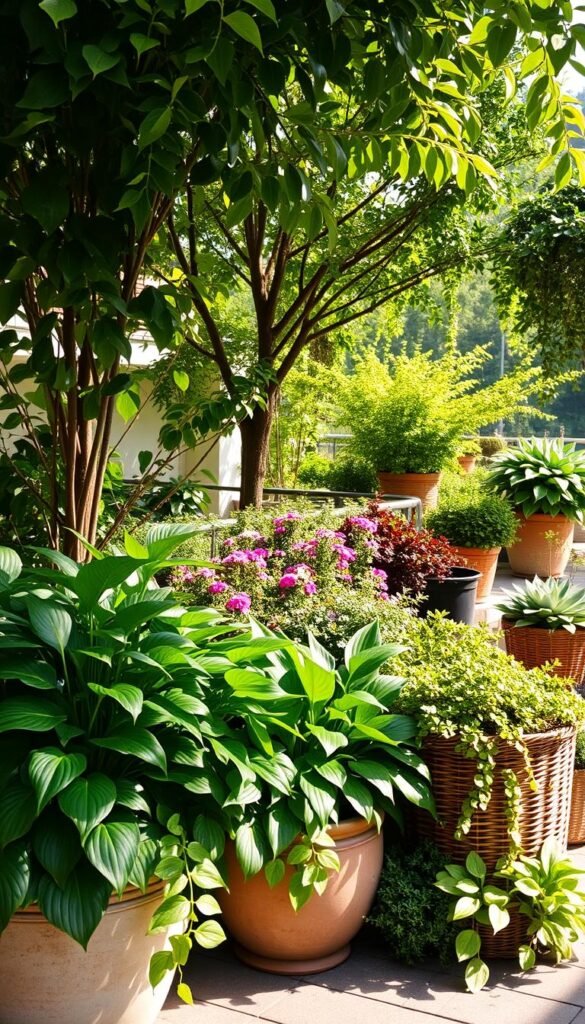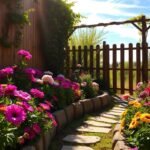Got a balcony or patio that sees more shadows than sunlight? You’re not alone. Many urban spaces and cozy yards struggle with limited light, but that doesn’t mean you can’t create a lush retreat. With smart design choices, even the gloomiest spots can burst with life.
Choosing greenery that thrives in partial shade is key. Species like impatiens and hosta are superstars here—they add texture and color without demanding constant sunshine. Pair them with bold, light-reflecting pots to make foliage pop. A sunny yellow planter or crisp white urn works wonders in dark corners.
Don’t be afraid to play with heights and groupings! Mix trailing vines with upright growers in stacked containers for visual drama. Experts like Proven Winners recommend strategic layering to maximize impact in compact areas.
Ready to turn those underused spaces into eye-catching displays? We’ll walk through plant picks, design hacks, and care tips to help your low-light oasis flourish. Let’s dig into the details!
Understanding Shade and Light Conditions for Your Garden
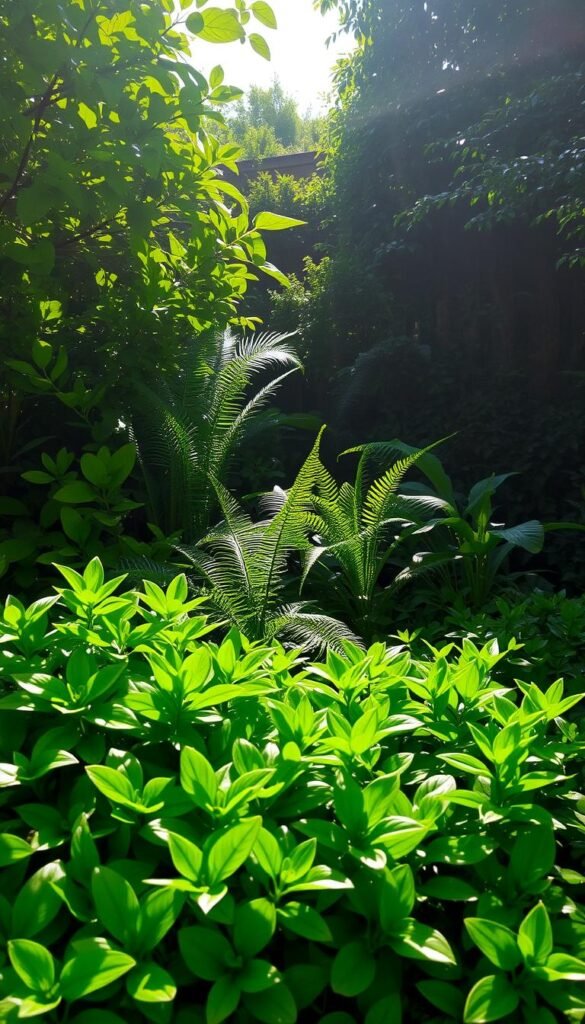
Light plays hide-and-seek in outdoor spaces, and winning the game starts with knowing the rules. Whether you’re working with a covered porch or a tree-lined corner, different shade types demand specific approaches.
Partial Shade vs. Full Shade Explained
Partial shade means 3-6 hours of sunlight daily, often with morning exposure. Think of spots under deciduous trees or east-facing walls. Full shade areas get less than 3 hours of direct sun—like north-facing spaces or under dense evergreens.
New Guinea impatiens show this perfectly. Their vibrant blooms thrive in partial shade but struggle in deep darkness. Meanwhile, coleus varieties with dark purple leaves often tolerate full shade better than their brightly colored cousins.
Assessing Your Garden’s Light Availability
Try this simple test: track sunlight every 2 hours for a day. Use a notebook or phone app to log patterns. Watch how light shifts with seasons—summer sun angles differ from winter’s.
| Light Type | Sun Hours | Best Plant Examples |
|---|---|---|
| Partial Shade | 3-6 hours | Begonias, Fuchsias |
| Full Shade | Hostas, Ferns | |
| Dappled Light | Filtered sun | Heucheras, Astilbes |
Boost dim areas with reflective surfaces. Place light-colored containers near walls or use metallic accents to bounce available light onto leaves. Rotate pots weekly to ensure even growth in lopsided light conditions.
Choosing the Right Containers and Potting Soil
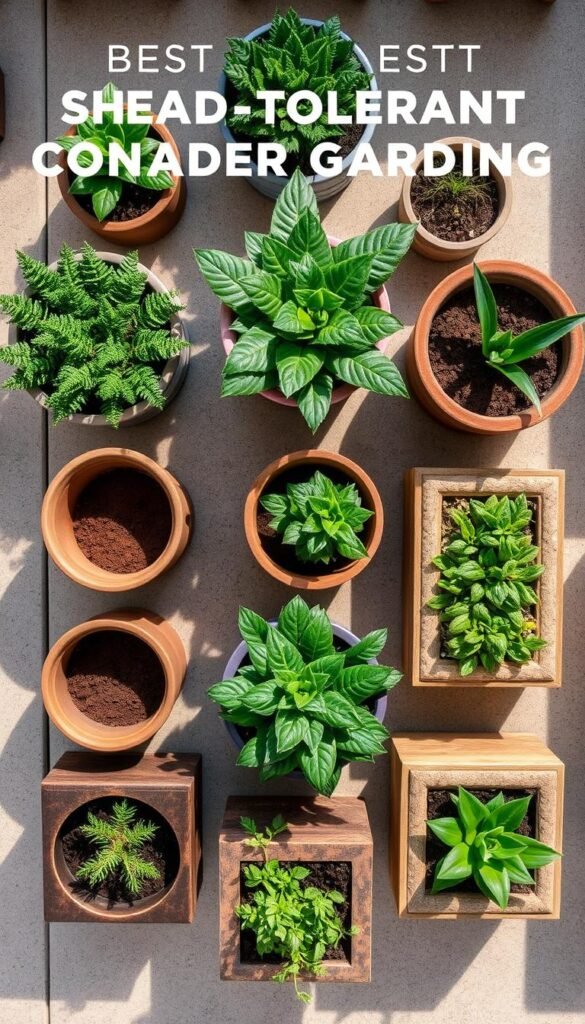
Your pot’s material and soil mix can make or break your shadowy garden oasis. While plants take center stage, their homes need equal attention. Let’s explore how to pair practical features with style.
Container Types and Drainage Essentials
Glazed ceramic pots retain moisture longer—perfect for breezy spots where soil dries quickly. Metal planters with drainage holes add modern flair while preventing water buildup. For root-sensitive species like ferns, try fabric grow bags that improve air circulation.
Drainage isn’t optional. Elevate pots using feet or gravel bases to avoid soggy roots. Pair light-colored vessels with silver-toned foliage to brighten dim areas naturally.
Soil Quality and Fertilizer Considerations
Standard garden dirt won’t cut it. Opt for potting mixes containing perlite or vermiculite—they keep roots oxygenated in humid shade. Mix in slow-release fertilizer pellets to nourish plants through summer months.
Refresh soil annually to combat nutrient depletion. In heavy rain zones, add extra bark chips to improve drainage without sacrificing moisture retention. Your greenery will reward you with vibrant growth, even when sun is scarce.
Container Gardening for Shade: Best Plants for Low-Light Spots
Shady areas become vibrant when you mix different plant personalities. Annuals deliver instant color bursts, while perennials offer reliable structure year after year. Foliage stars steal the show with eye-catching patterns that shine even without flowers.
Seasonal Showstoppers vs. Lasting Lovelies
Annuals like wax begonias work magic in dark corners with their nonstop blooms from spring through frost. They’re perfect for quick transformations in hanging baskets. Perennials such as ajuga provide groundcover-like texture in pots, returning each season with minimal fuss.
Leafy Legends That Thrive in Shadows
Coleus varieties turn containers into living art with their flame-patterned leaves. Pair them with rex begonias for metallic sheens that catch faint light. Garden designer Janet Loughrey suggests combining spiky carex grass with round-leaved heucheras for contrast.
Try these pro tips for striking displays:
- Use trailing ivy in elevated planters to draw eyes upward
- Group three-sized containers for layered depth
- Add glow with white-variegated plants like caladiums
Proven Winners’ ‘Shadowland’ hosta collection proves foliage can outshine blooms. Remember—match leaf textures to your space’s light reality. Velvety plants often handle deeper shade better than glossy types.
Top Shade-Loving Annuals for Containers
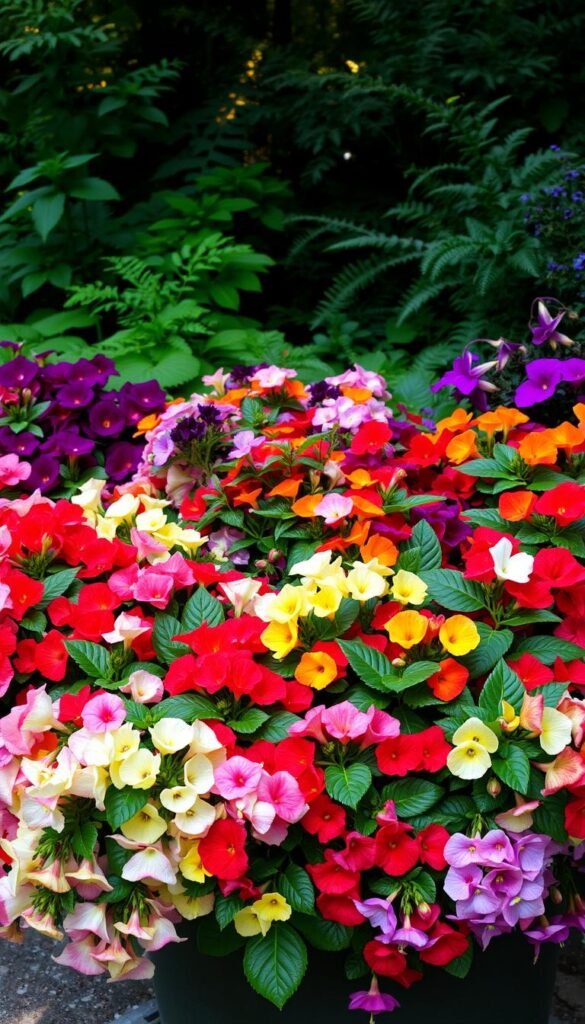
Transform dim corners into lively displays with annuals built for shadowy living. These seasonal performers pack punches of color through vivid flowers and striking foliage. Let’s explore crowd-pleasers that keep pots vibrant from spring to frost.
Impatiens and New Guinea Impatiens
Rockapulco® Rose impatiens burst with roselike blooms that flourish in partial shade. Their traditional cousins offer softer textures with delicate petals, perfect for softening container edges. New Guinea varieties like ‘Sunpatiens’ boast thicker leaves and handle morning sun better while maintaining bloom power.
Deadheading spent flowers weekly keeps these plants producing new buds. Pair them with lime-green sweet potato vine for contrast—their trailing habit balances impatiens’ mounded shape.
Fuchsias and Coleus Varieties
Fuchsias dangle jewel-toned flowers resembling tiny ballerinas, thriving in cool, shaded spots. Coleus steals attention with painterly leaves in burgundy, chartreuse, or peach. ‘Wizard Mix’ coleus varieties adapt well to pots, needing minimal deadheading.
Combine feathery fuchsia textures with bold coleus patterns for dynamic duos. Both benefit from monthly liquid fertilizer to sustain their showy displays. Rotate pots every 10 days to prevent lopsided growth toward faint light sources.
Best Perennial Plants for Shaded Container Gardens

Year-round beauty doesn’t require constant replanting when you choose perennials built for shady spots. These reliable performers return season after season, offering texture and color even where sunlight plays hard to get.
Hosta Varieties and Their Care
Hostas reign supreme in dim settings with their sculptural leaves. ‘June Fever’ and ‘Blue Mouse Ears’ varieties thrive in container gardens, needing only morning light. Keep soil consistently moist but never soggy—add compost annually to maintain nutrient levels.
Slugs love hostas as much as gardeners do. Sprinkle crushed eggshells around the base or use copper tape on pots. Rotate containers monthly to ensure even growth patterns in uneven light.
Begonias, Coral Bells, and Other Foliage Beauties
Pair rex begonias’ metallic leaves with coral bells’ ruffled edges for a textural feast. These combos work wonders in container gardens, especially when layered with trailing sweet potato vine. The vine’s heart-shaped leaves soften planter edges while thriving in low light.
For pops of color, mix new guinea impatiens among foliage plants. Their vibrant blooms last from spring through fall with weekly watering and bi-monthly fertilizer. Refresh potting mix every 2 years to prevent soil compaction.
Pro tip: Use dwarf varieties of perennials like ‘Lemon Coral’ sedum to maximize space. Their compact size lets you create lush arrangements without overcrowding. Combine with sweet potato vine for vertical interest and new guinea impatiens for seasonal flair.
Creative Container Arrangements for Low-Light Spots
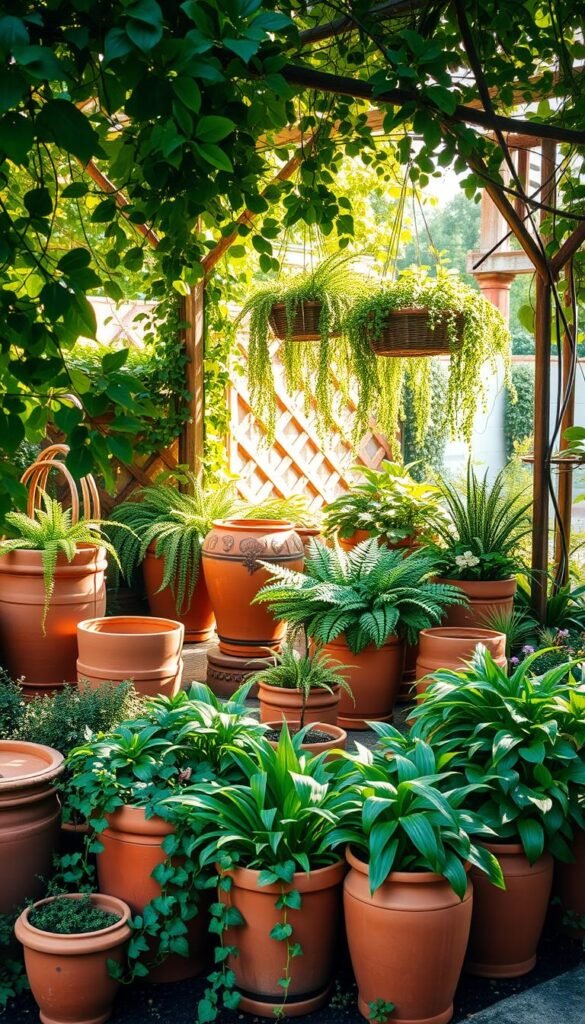
Dark corners deserve design flair too. Transform overlooked areas into living art with clever plant pairings and vertical elements. The trick? Balance bold textures with strategic pops of color while working with your space’s light reality.
Mixing Textures and Colors
Combine feathery ferns with glossy sweet potato vine for instant contrast. The vine’s heart-shaped leaves cascade beautifully, while its chartreuse hue brightens dim zones. Add depth with New Guinea impatiens—their vibrant blooms thrive in partial shade and complement silvery foliage plants.
Proven Winners suggests trios like:
- Spiky carex grass + rounded heuchera + trailing ivy
- Velvety rex begonia + striped caladium + sweet potato vine
These combos work wonders in full shade, especially when grouped in odd-numbered clusters. Use metallic or white pots to reflect existing light onto darker leaves.
Innovative Ideas with Hanging Baskets
Elevate your design—literally. Hanging baskets add height to patios while showcasing shade-loving stars. Try fuchsias with their jewel-toned blooms paired with variegated ivy. For full shade spots, mix trailing English ivy with upright astilbes.
Maximize impact with these hanging basket hacks:
- Line wire baskets with moss for rustic charm
- Use pulley systems for easy watering access
- Layer New Guinea impatiens over sweet potato vine
Don’t shy away from bold hues. A colorful container gardening approach energizes shadowy walls. Rotate baskets monthly to ensure even growth toward filtered light sources.
Boosting Growth in Partial Shade Environments

Growing plants in partial shade isn’t just about survival—it’s about helping them thrive with smart strategies. Three factors make the difference: precise watering, targeted feeding, and clever light management. Let’s break down how to optimize each element for your leafy companions.
Watering and Feeding Essentials
Water early to reduce evaporation and nutrient loss. Guinea impatiens prefer consistent moisture—check soil daily with your finger. If the top inch feels dry, water until it drains from the pot’s base. For coral bells, let soil dry slightly between waterings to prevent rot.
| Fertilizer Type | Best For | Frequency | Examples |
|---|---|---|---|
| Water-soluble | Quick nutrient boosts | Every 2 weeks | Miracle-Gro® |
| Timed-release | Low-maintenance feeding | Every 3 months | Osmocote® |
| Organic compost | Soil health | Spring & fall | Worm castings |
Pair potato vine with slow-release pellets—their vigorous growth needs steady nutrition. Reflective surfaces amplify limited light. Try placing aluminum foil behind pots or using white decorative stones as mulch. These tricks help coral bells develop richer leaf colors.
Rotate your container garden weekly to ensure even light exposure. Guinea impatiens will lean toward light sources otherwise. Monitor leaves for yellowing—a sign to adjust watering or feeding. With these tweaks, your partial shade plants will outperform sunny rivals!
Design Inspiration from Proven Garden Experts

Designing a shadow-friendly oasis? Top horticulturists like Vina Winters and Lucy Hardiman reveal how to craft showstopping arrangements. Their award-winning layouts blend color, texture, and smart potting soil choices to elevate dim spaces into living masterpieces.
Curated Shade Combinations and Layouts
Hardiman’s signature trio pairs silver-spotted lungwort with ruby-toned heuchera and cascading ivy. This mix thrives in container gardening setups, offering year-round interest. Winters suggests grouping planters in triangular formations—tall ferns at the back, mid-height begonias, and trailing vinca minor spilling forward.
| Design Style | Plant Combo | Potting Tip |
|---|---|---|
| Modern Monochrome | Black mondo grass + white caladiums | Add perlite for drainage |
| Tropical Escape | Elephant ears + golden pothos | Use compost-enriched mix |
| Woodland Charm | Japanese painted fern + dwarf hosta | Mulch with cocoa hulls |
Tips from Award-Winning Container Gardens
Winters swears by plants like variegated Solomon’s seal for vertical drama. “Their arching stems create movement,” she notes. For shade plants, Hardiman recommends layering textures: pair velvety leaves with glossy counterparts like asarum.
Upgrade your potting soil game with these pro moves:
- Mix worm castings into store-bought soil for slow-release nutrients
- Line pot bottoms with coffee filters to prevent soil loss
- Refresh top 2″ of soil monthly in heavy-feeding shade plants
Try Winters’ favorite trick: tuck chartreuse-leaved plants like creeping Jenny between darker foliage. This creates instant contrast, making arrangements pop even in low light. Rotate planters quarterly to maintain balanced growth patterns.
Maintenance Tips for Your Shade Container Garden
Keeping your leafy oasis thriving requires consistent care. Like a well-tuned instrument, plants in dim areas need regular attention to maintain their rhythm. A little effort goes a long way in preventing leggy growth and pest invasions.
Pruning and Deadheading Essentials
Snip spent blooms weekly on shade-loving plants like begonias to encourage new flowers. For trailing varieties such as creeping Jenny, trim overlong stems to promote bushier growth. Portland’s Lan Su Chinese Garden uses this technique to keep their container gardens lush year-round.
Rotate pots every 10 days to prevent uneven growth. In warmer zones (7-9), increase pruning frequency during humid summers. Always use clean shears—wipe blades with rubbing alcohol to avoid spreading diseases.
Smart Soil and Pest Strategies
Refresh potting mix each spring for vigorous growth. Atlanta Botanical Garden experts replace the top 3 inches of soil in their shade gardens, mixing in worm castings for nutrients. Apply slow-release fertilizer in early summer to sustain plants like heucheras.
Combat pests naturally:
- Spray neem oil on spider mite-prone ferns
- Sprinkle diatomaceous earth around hostas to deter slugs
- Introduce ladybugs to control aphids on coleus
Adjust care by zones. Northern gardeners (3-6) should mulch heavily before frost, while southerners (7-10) benefit from afternoon misting. For small-space solutions, try compact varieties that require less frequent upkeep.
Troubleshooting Common Issues in Shade Gardening
Even thriving plants sometimes need troubleshooting. Spotting problems early keeps your green friends happy. Let’s tackle two sneaky culprits: waterlogged roots and hungry plants missing key nutrients.
Identifying Overwatering and Nutrient Leaching
Soggy soil causes more harm than drought in shady spots. Yellow leaves and moldy stems scream “too much water!” Check soil moisture before watering—poke your finger 2 inches deep. If it’s damp, wait another day.
Nutrient deficiencies show through pale leaves or stunted growth. Fast-draining pots lose fertilizer quickly. Use slow-release formulas to feed plants steadily. Organic compost tea works wonders every 3 weeks.
| Issue | Signs | Quick Fixes |
|---|---|---|
| Overwatering | Wilting + wet soil, fungus gnats | Add perlite to soil, use pots with drainage holes |
| Nutrient Loss | Yellow edges, weak stems | Apply balanced fertilizer, mulch with compost |
| Salt Buildup | White crust on planter rims | Flush soil monthly, switch to liquid feeds |
Choose planters with multiple drainage holes. Line baskets with coffee filters to prevent soil washout. For heavy feeders like ferns, mix worm castings into potting mix. Rotate pots weekly to ensure even drying.
Got a favorite planter without drainage? Place a layer of gravel underneath the soil. It creates an air pocket to protect roots. Pair this hack with moisture meters for precision care.
Try these ideas from Cornell University’s horticulture team: water in the morning, and use glazed pots for moisture-sensitive plants. Track growth in a journal—patterns help you adjust routines before issues escalate.
Wrapping Up Your Shade Container Garden Journey
Your journey into shadow-friendly plant design doesn’t end here—it evolves. With smart choices like ferns for texture and hanging baskets for vertical flair, dim spaces become dynamic showcases. Remember—success lies in matching plants to your light reality while embracing creative freedom.
Whether you’re nurturing delicate ferns or bold potato vine, consistent care makes all the difference. Rotate pots regularly as part of your routine to ensure balanced growth. Those hanging displays with trailing ivy? They’re not just pretty—they maximize limited space brilliantly.
Don’t shy from experimentation. Mix glossy leaves with matte finishes in your part-shade arrangements. Pair chartreuse potato vine with deep-green hostas for eye-catching contrast. Share your triumphs online—inspire others tackling similar light challenges!
Final tip: Refresh soil annually and choose self-watering pots if maintenance time is tight. Your fern-filled oasis proves shadows aren’t limitations—they’re invitations to grow differently. Now go make those gloomy corners glow!

